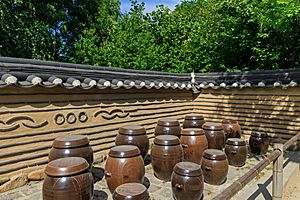Jangdokdae facts for kids
| Jangdokdae | |

Jangdokdae at Gyeongbok palace in Seoul
|
|
Quick facts for kids Korean name |
|
|---|---|
| Hangul | |
| Hanja |
醬-臺
|
| Revised Romanization | jangdokdae |
| McCune–Reischauer | changtoktae |
In Korean culture, a Jangdokdae (Hangul: 장독대) is a special outdoor area, often like a terrace. It is used to store and ferment traditional Korean foods. These foods, like Kimchi, soybeans, and different kinds of pastes (bean and red pepper), are kept in special earthenware jars called Jangdok or Onggi. These jars are then placed on the Jangdokdae.
Contents
What is a Jangdokdae?
A Jangdokdae is an important part of a traditional Korean home. It's an outdoor space designed specifically for food storage. Think of it as a pantry, but outside, where special jars hold delicious Korean ingredients.
Why are Jangdokdae important?
The main purpose of a Jangdokdae is to help foods ferment and stay fresh. Fermentation is a process where food changes over time, often becoming more flavorful and easier to digest. The special jangdok jars protect the food while it ferments. This allows many ingredients to be stored safely for a long time, sometimes even for several years!
Where are Jangdokdae Found?
You will usually find a Jangdokdae right next to traditional Korean houses. They are often placed close to the kitchen. This makes it easy to get ingredients while cooking.
Choosing the Best Spot
Finding the right spot for a Jangdokdae is very important. It needs plenty of sunlight and good air flow, also known as ventilation. Sunlight helps the fermentation process. Good air flow keeps the jars and food in good condition. These conditions are key to keeping the food preserved and fresh for a long time.
The Meaning Behind the Name
The word "Jangdokdae" has a simple meaning in Korean.
- Jangdok (Hangul: 장독) means "crock" or "jar." These are the special jars used for condiments and soy sauce.
- Dae (Hangul: 대) means "place" or "support."
So, Jangdokdae (Hangul: 장독대) literally means "a place for jangdok jars." The jars themselves are also called hangari (Hangul: 항아리) or onggi (Hangul: 옹기).
Jangdokdae in Royal Palaces
Even royal palaces in Korea had similar areas for storing food. These royal Jangdokdae were called yeomgo (염고). A special court lady was in charge of these areas. She was known as janggo mama (장고 마마). Her job was to make sure the royal food ingredients were stored perfectly.


